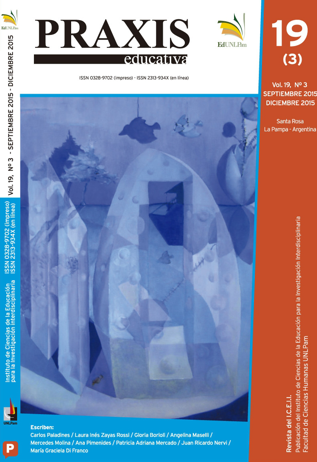Young people and Adults´ Secondary School Teachers facing Educational Inclusion
Keywords:
lifelong learning, secondary level, educational inclusion, social representationsAbstract
The article aims to analyze the social representations of teachers about the processes of educational inclusion in secondary education for youth and adults. This approach is built on the basis of the inclusion of sectors that were excluded from the possibility of exercising the right to education. The ways in which teachers give meaning to inclusion is what we want to know, through the conceptual framework provided by the theory of social representations. The methodology combined qualitative and quantitative data collection strategies. The findings lead to affirm that social representations of teachers are complex and are traversed by contradictory conceptions. There is confidence in the possibilities of transforming and improving life opportunities offered by education, while underlying characteristics of a school closer to reproductivism positioning notions and meritocratic perspective.
Downloads
Downloads
Issue
Section
License
Copyright Notice
Editorial Committee Educational Praxis Magazine:
I hereby declare that I am the author of the article titled (article name), that it is original and my own and that it was not previously published in any other format or medium. I declare to know that the magazine will not charge me any type of fee under any circumstances, nor will I receive any type of monetary compensation If it were accepted for publication in Educational Praxis, I authorize the aforementioned magazine to publish it digitally and to advertise it on its social networks.
If the work is published, I adhere to the Creative Commons license called "Attribution - Non-Commercial Share Alike CC BY-NC-SA", through which it is allowed to copy, reproduce, distribute, publicly communicate the work and generate derivative works, as long as when the original author is cited and acknowledged. This license has been used since September 2018. In 2016 CC BY NC ND 4.0 was adhered to; and in the years 2017 and 2018 (January-August) CC BY NC 4.0.
This CC BY-NC-SA Share Alike license does not, however, permit commercial use of the work. As an author, the journal may establish additional agreements for the non-exclusive distribution of the version of the work published in the journal, it allows me to self-archive the published articles, in their post-print version, in institutional, thematic repositories, personal web pages or any other relevant use. with the recognition of having been first published in this journal.
Educational Praxis adheres to DORA (Declaration on Research Assessment) signed in San Francisco, California, on December 16, 2012, and to the Declaration of Mexico (Joint Declaration LATINDEX - REDALYC - CLACSO - IBICT).











_(1)2.png)


3.png)











_(2).png)






2.jpg)









